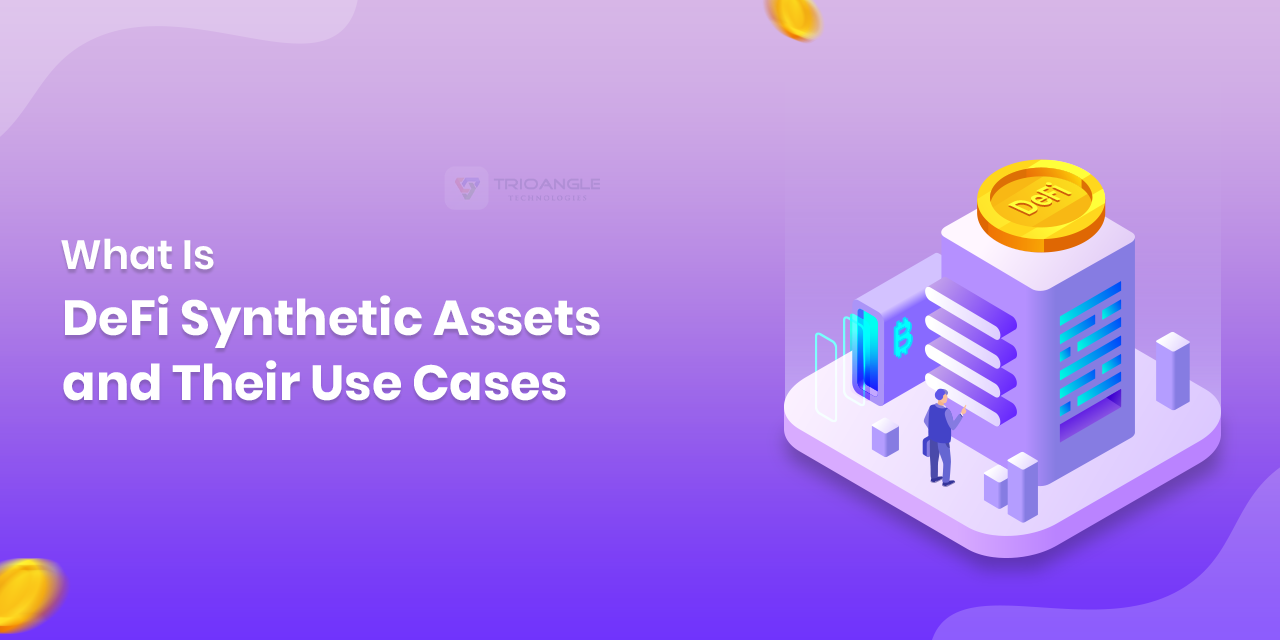Imagine being able to trade things like stocks, gold, real estate, and more without actually owning them. Sounds like a dream, right? The DeFi synthetic assets make this possible. These are blockchain-based digital versions of real-world assets that permit you to trade without owning the physical asset.
In this blog, let’s explore what DeFi synthetic assets are, their role in finance, and their use cases in a decentralized world.
So, let’s get started.
What Are DeFi Synthetic Assets?
Synthetic assets, also known as “synths,” are digital forms of assets that imitate the value of real global assets, which can be anything from stocks to gold etc. These synthetic assets follow the price movements of real-world assets, For example, if the price of gold goes up, the synthetic gold asset price will go up too.
Here, the smart contract’s code instructs it to mirror the price movements of the physical, tangible assets automatically. It allows users to trade gold or bitcoin-valued assets without buying them. You need only a cryptocurrency wallet and a bit of collateral to start trading these synthetic assets on the DEX.
How Does It Work?
With synthetic assets, you can speculate on the price of Ethereum (ETH) without holding any ETH.
Let’s look at how synthetic assets are created using an example of synthetic Ethereum (sETH) on the Polygon blockchain network.
1. Collection of Price Data Via Oracles
First, the decentralized oracles collect real-time Ethereum price data from multiple trusted exchanges. These oracles feed accurate price information to the smart contracts managing synthetic assets.
2. Creating Vault and Token
A vault, which is a type of smart contract, is created to hold collateral and issue synthetic tokens. In this case, the synthetic token is sETH. A collateralization ratio is also established to decide how much MATIC (or other tokens) must be deposited to mint the sETH.
3. Depositing Collateral and Issuing Tokens
Users deposit MATIC or other accepted cryptocurrencies into the vault as collateral. And they receive sETH tokens in return, which represent the price of Ethereum without needing them to hold actual ETH.
4. Price Evaluation and Adjustments
The vault’s smart contract continuously oversees Ethereum’s price via oracles and alters the value of sETH to match real-time ETH prices. This mechanism ensures that synthetic tokens like sETH stay aligned with the real-world asset they represent.
5. Synthetic Asset Created
As a result, the synthetic Ethereum (sETH) imitates the price of real Ethereum, and it is collateralized by MATIC or another cryptocurrency in the vault to maintain its value. This (sETH) allows one to execute trading, yield farming, or hedging without owning the ETH.
Right, let me tell you the role of DeFi synthetic assets in finance now.
Role Of Synthetic Assets in Finance
1. Opening Doors to Global Markets
Traditionally, trading things like stocks or commodities requires special accounts or access to specific countries. But in contrast, synthetic assets allow anyone with an internet connection to invest in the global markets.
2. Making Ownership Easier
Investing in a tangible asset like gold or real estate can be overwhelming and expensive. You need to proceed with a mountain of legal paperwork. But this synthetic asset made this easier; it removes obstacles and permits you to track and profit from the value fluctuations of these assets without holding them or dealing with all the hassle.
3. Reducing Risk and Protecting Your Capital
You can manage risk in your portfolio with synthetic assets. For example, if you are a person who worries about the price changes of cryptocurrencies, holding synthetic assets is better for you, because these assets are tied to more stable or diversified assets. They offer a safer and more predictable investment option for people who are cautious about market fluctuations.
4. Opening Up More Investment Options
By using synthetic assets, you are able to invest in markets that were once challenging to enter. For example, you can buy or invest in the synthetic shares of a company located in a different country easily, which opens up more investment opportunities without the burden of complicated rules or barriers.
Popular Synthetic Assets
Well, let’s see some well-known synthetic assets now.
sBTC (Synthetic Bitcoin)
sBTC, known as Synthetic Bitcoin, is crafted to imitate the value of Bitcoin crypto. Users can experience Bitcoin’s price changes without really owning the cryptocurrency. Synthetic assets provide a simplified way for users to participate in trading and investment strategies within DeFi, enabling decentralized exposure to Bitcoin’s value.
sUSD (Synthetic USD)
sUSD is a synthetic asset that mimics the value of the US Dollar. Its consistent value makes it a favored option for users for trading, lending, and borrowing in decentralized finance (DeFi) platforms. This consistency helps users mitigate risks and make trades with greater accuracy.
sETH (Synthetic ETH)
sETH tracks the value of Ethereum cryptocurrency, enabling users to trade or invest in its price shifts through synthetic methods. This asset provides an easy way to engage with Ethereum’s value without owning the cryptocurrency.
sGold (Synthetic Gold)
sGold follows the value of gold, users can trade in gold prices via synthetic assets. This serves as an alternative to owning physical gold and traditional financial systems. It enables gold trading in the DeFi industry.
sAAPL ( Synthetic Apple Stock)
sAAPL tracks Apple Inc.’s stock price in real-time. With this, users can connect with Apple’s market trends in the DeFi landscape. With this synthetic asset, users can gain exposure to Apple’s stock performance independently of traditional financial markets.
What are the Use Cases of Synthetic Assets?
Right, you come across the essential things. Let us see the use cases of these synthetic assets.
Liquidity Creation
Synthetic assets play a major role in improving market liquidity by facilitating traders through derivatives such as credit default swaps [CDS]. These contracts help buyers to shield against credit risk while sellers take on exposure to the underlying asset synthetically. It helps to improve liquidity and supports a range of trading strategies.
Risk Hedging
Using synthetic assets for risk hedging helps traders merge the value of various underlying assets into a single synthetic product, monitored by oracles. This benefits traders by shielding them from drops in the value of specific assets while taking advantage of the potential increases in others.
Market Access
Synthetic assets open the door to markets that may be challenging to access otherwise. By replicating the value of traditional assets like stocks and bonds, they benefit from price fluctuations without needing to own the assets directly or deal with complicated regulations.
Right, we’ve come to the end of the topic: “What Are DeFi Synthetic Assets and Their Use Cases”.
Whether you have an existing business or are exploring DeFi business ideas. You can establish a business in the DeFi sector by developing your software focus on DeFi synthetic assets. If you’re an existing DeFi platform owner, you can gain huge benefits with the DeFi synthetic asset development for your platform. So, now you doubt like…
Where Can I Develop a DeFi Synthetic Asset?
The best and most trusted choice is Trioangle. As a leading DeFi Development Company, we provide robust smart contracts and customized blockchain-based digital assets that imitate the value of global assets like gold, stocks, and more. Also, we craft DeFi synthetic assets-focused protocols as per your requirements.








